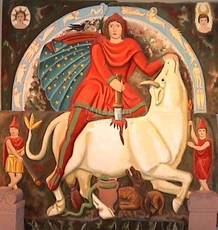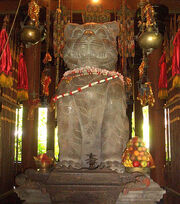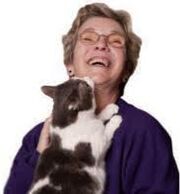(Created page with "{| class="infobox" rules="all" border="0" cellpadding="4" cellspacing="0" style="float: right; width: 270px; font-size: 85%; margin: 0 0 1em 1em; border: 1px solid #999; backg...") |
No edit summary |
||
| Line 8: | Line 8: | ||
|'''Holy City''' || Various |
|'''Holy City''' || Various |
||
|- |
|- |
||
| − | |''Resurgence''' || 30:th century |
+ | |'''Resurgence''' || 30:th century |
|- |
|- |
||
|'''Theistic Philosophy''' || Pantheistic, Polytheistic |
|'''Theistic Philosophy''' || Pantheistic, Polytheistic |
||
Revision as of 11:56, 13 June 2013
| Felinism Nkaé | |
|---|---|
| Symbol of the Faith | |
| Presence | Barmenia, Beluzia, Al'Badara, Rildanor, Keymon, Cildania, Mordusia, Pontesi, Selucia |
| Holy City | Various |
| Resurgence | 30:th century |
| Theistic Philosophy | Pantheistic, Polytheistic |
| Worshippers | 300-400 million (Est.) |
Overview
Felinism (Brmék: Nkaé) is an animalistic religion centred around the idea of feline spices as being divine beings, that hails from the indigenous pagan religion practised by the early Proto-Rhaetans of Barmenia. Many archaeological findings tell of the reverence of cats from this date, especially in the ancient ziggurats found in Barmenia.
Felinism was long a religion of peasants and mountainous villagers in the predominantly Queranz Barmenia, but rose into prominence once again after the collapse of the monarchy of the Selucianist House of Victoria. Led by the charismatic Lady Elizabeth Rochford, the Cult of the Sacred Feline established itself as the state religion of Barmenia, with her daughter, Jessica Rochford taking on the worldly leadership over the state. However, little religious persecution did exist during the time, and many chose to combine their felinist beliefs with other religions. The resurgence of Felinism has been explained by historians as a combination of the decline of Queranzariah during the previous regime, combined with a vacuum of social instability that allowed a charismatic leader and a movement with a clear vision to rose to power.
Theology
At the centre of Felinist worship lies the idea of "Discerning the General Feline Will". The term describes the process or state of mind which enables one to humbly wait upon the Feline Divinity for guidance. Discernment may be conducted in a multitude of ways as there are no rigid rules. A believer can do it whilst riding a bike in the park or watching television with a cat sat on your lap. You may find yourself entering the state of discernment whilst in discussion with friends or colleagues. Felinists often rely on a Guide, meaning a cat who has come forward to help that person make their life choices.
Orthodox Felinists, like Lady Elizabeth and the priesthood of the Sacred Cult, literally believe that cats comprise the Godhead or Feline Divinity and that serving cats is the moral purpose humans are created for. Less orthodox Felinists, whilst according cats the highest place of honour, may take a more pantheistic view, seeing the worship of cats as a powerful metaphor for developing a closer relationship with the spirituality present within ourselves and in nature. As previously stated, others take a syncretistic approach, venerating cats whilst also drawing on concepts from other religions. It is common for Felinists to also regard themselves as, say, Hosians, Queranzariah, Abadi, Ehudi or Daenists and still feel comfortable with their beliefs and be fully accepted within the Felinist community. Felinists tend to feel especially close to other nature-based religions, such as paganism and Heathenry.
Felinists regard their faith as a natural religion which has always existed in some form or degree, and so are reluctant to credit any single individual as being their founder. However, Lady Elizabeth is inarguably the spark that began the modern Felinist movement. Although personally a very modest woman who shies from public attention, she has acquired the status of a towering figurehead not only for the Sacred Cult and Felinism but for Barmenia itself.
Gods and denominations
During the resurgence of the faith under Lady Elizabeth and the Sacred Feline Cult, all cats were considered parts of the Feline Divinity, but the one worthy of special reverence was Bastat, who was said to be the Goddess of Fertility worshipped in ancient times. The Felis Supremis is believed to be the latest incarnation of Bastat. Whenever a Felis Supremis dies, believers subsides into ten days of official mourning, during which followers cease all significant business activity, fast, pray, donate their riches to Cat Temples and wail loudly through the streets whilst crawling on all fours with their eyes facing downwards, fearing that unless Bastat returns the plants will all die and all living life perish. On the eleventh day a search begins, supervised by the Sacred Cult, to find the next Felis Supremis from amongst the kittens in Barmenia's most prominent Cat Temples. The selected kitten is usually a queen (female), although there have been occasions when Bastet has chosen to return as a tom (male). After the new Felis Supremis has been anointed, there follows a spontaneous outburst of religious fervour and wild celebrations.
Pantherism
However, as time has passed, several other denominations has risen into prominence, many of them drawing concepts from other religions. One that rose to prominence and became the official state religion of Barmenia for a time was Patherism, who held Panthers to be the perfected incarnation of the Feline Divinity. Patherists often follow a philosophy of anarchistic primitivism, shunning civilization and it's authoritarian structures for the wild natural state of all living creatures. Pantherists consider felines to be individual savages and that following one's inner savage is paramount to discerning the Feline Will. A common Patherist slogan is that “the white tigers are keeping us down!”, not interpreted as a literal opposition to white tigers but a symbolic reference to how the organized white tigers of civilization oppresses the natural savage instinct of the panther.
Cult of the Embreon
Another popular sect that has rose into prominence is the Cult of the Embreon, a sect of Felinism that, while still worshiping the Cat Gods, does not see them as individual divine beings; but rather as faces of an infinite, formless, god-like consciousness. This consciousness watches over and guides the Embreon on its way to becoming one of these infinite consciousness', to guide its own Embreon. There are an infinite number of Embreons, Consciousness' and Universes. Every Terran is one and the same, they are all simply reincarnations of the Embreon.
Time is relative to Embreonic-Felinists. Time only really exists as the personal timeline of the Embreon. When each individual life dies, he or she is reincarnated into another life somewhere in history. Time is but an illusion. A person can be reincarnated into the past, or into the future in accordance with their most recently completed life, however when each individual life is reincarnated, the next life that the Embreon encounters is farther ahead in it's own time stream. He/She could be reborn into the Past, Present or Future. He/She could be a Kizenian Politician in 2548, or a Barmenian Priest in 4572, or an Al'badaran in 1743. In this way the Embreon is everyone at the same time, but is still only one person at a time. The only way for the Embreon to become one of the Consciousness' is to experience every Terran life; to see its wonders, its hardships, its palaces and its slums. To know the sting of poverty and the wonder of exploration.
Embreonic Felinists see Cats as divine extensions of the consciousness, and therefor worthy of Worship and Reverence as a symbol of a more perfect Terran, a more perfect Embreon who has paid his dues.
Lionism

Terek killing the bull
The oldest heterodox felinist sect is the Temple of Lions, who rose into prominence after an influx of Selucianist Hosian refugees into Barmenia after the Pontesian Civil War. Lionists adhere to a stricter and more hierarchic religious code than traditional felinists, and places special importance on self-actualization and rising into prominence through obeying one's family leaders and one's superiors as discerning the Feline Will.
Lionists, as the name suggests, has a special reverence for lions, considered to be the children of the Sun God Azaeran, who supposedly lives inside the Sun. As a result, Lionist priests are often refers to as “Sun Priests”. God and red are their liturgical colours, and fire is considered a sacred element, as it is believed to have originated from the Sun. Lionist preachers sometimes use television as a medium for evangelization, but this has been criticized by orthodox felinists as these televangelists usually asks the viewers to donate money to receive blessings from Azaeran.
A popular legend promoted by Lionists is that of the demigod Terek the Bullslayer. Born out of a rock somewhere among the mountains of Sisula, far from even the remotest village, Terek set out to find his purpose in life. He came to a city were the citizens were terrorised by a demonic bull. The bull demanded to receive a cat to eat every day from the inhabitants of the city, otherwise he'd slaughter them all. As Terek protested this injustice and was sentenced to death by fighting the bull, a burning golden sword appeared in his arm. After a long fight, he managed to kill the bull, which caused an earthquake. The city was destroyed, and the inhabitants who had agreed to sacrifice their cats to the bull all perished. Cutting the bull into pieces to be used as food for the few survivors, upon opening the stomach, Terek found all the cats consumed by the bull well and alive. He was then taken to the Sun by a chariot driven by seven pegasi to dinner with the Azaeran, who revealed himself as his father and Terra itself as his mother. Terek is considered the most perfect man ever born by Lionists, but while this story is taken a literal truth by some fundamentalists, it is nowadays considered a metaphor by most.
Eredian Bear and Dog Cult
Another sect from Barmenia, not considered part of Felinism per see, are the Eredian Bear and Dog cult. Called apostates by most felinist priests, this sect revered natural predators of cats such as bears and dogs. They are usually considered a product of youth rebellion against Felinist society and are for Felinists what Satanists are for Hosians.
Rituals
Outsiders are sometimes perplexed that the rules of the Sacred Cult require its Priesthood to include meat in their diet, prohibiting them from being vegetarians. This does not stem from any disapproval of vegetarianism; many Felinists are vegetarians, and the Sacred Cult sponsors a special society for Felinist vegetarians. The issue is that being a Priest or Priestess requires an intimate embracing of the carnivorous attribute of the Feline Divinity. Some of the priestly rituals also require a priest or priestess to eat live food whilst entranced by cosmic feline forces.
It is videly believed that the ziggurats of Barmenia, built millenniums ago, were intended as sacrificial pits were worshippers could sacrifice rats and other appreciated meals to decreased cats, though few such sacrifices occur today.
A controversial ritual celebrated predominantly by Lionists is the yearly Midsummer Sacrificial Feast, were worshippers gather at ancient shrines and ziggurats to “sacrifice” honey mead by drinking it, thanking their gods for this gift. This is considered blasphemous by some orthodox felinists as cats do not drink alcohol. Lionists defend themselves by saying that mead, which has for long been a popular drink in Barmenia, is a gift from the Feline Divinity to their humans. Some consider this feast to be a provocation intended against the Queranz population in Barmenia, as the followers of Queranzaraiah are forbidden from drinking alcohol.
Structure

The famous Altar of Bastet at the East Sisula Cat Temple
The origins of modern felinism lies in the Cult of the Sacred Feline, known as the Sacred Cult, which was founded by Lady Elizabeth Rochford following a rich spiritual journey stretching across four decades of companionship with cats. After receiving revelation of the innate omniscience of cats, she set up the Sacred Cult in order to share the secrets of feline wisdom with those less privileged than herself.
The Sacred Cult is relaxed about the diversity within Felinism, requiring conformity to orthodox teaching only from its registered priesthood. Most Barmenian cities, towns or villages are blessed with a network of Cat Temples. Cat Temples are run for and by their cat residents, whose wishes are communicated to their appointed priests and priestesses who administer their decisions into practice. The average Temple features every facility for cats; plenty of space for them to roam inside and outside; and opportunities for worship and discernment, including shrines and religious seminars. Many Temples site farms and specialist kitchens on campus in order to provide the highest quality of fresh produce and cooked meals for their residents.
The Temple Priesthood are assisted by a secular class of Servers, who may work in a Temple on a permanent or temporary basis. Most Barmenians spend at least several months of their lives as Servers. The experience is considered both personally and spiritually invigorating, and is a social rite of passage for young adults. Many Barmenians spend a large chunk of their active post-retirement years as Servers.
Evidence substantiates the wonderful therapeutic value of working in an environment ruled by cats. Many of the sick, especially those with mental health problems, have experienced an improvement in their condition after working as a Server. This experience is also proven to help rehabilitate convicted criminals from prisons who have been assigned to Temples on special secondments. Barmenians have the Feline Divinity to thank for this and much, much more.
Most Felinists spend time in consecrated Cat Temples expertly designed to encourage personal encounters with the Feline Divinity. The physical presence of cats and a cat-honouring environment is conducive to accessing the profundity of cat sprituality, but is neither essential nor a guarantee of success, since what is sought comes from a higher plane than the material world we perceive around us with our limited human senses. Cats see far more than this, and they are generous animals who may share their visions if we approach them in the right way.
On that last note, a frequent pitfall, especially for newcomers to Felinism, is to consciously or unconsciously demand instant answers. Seekers commonly become so intoxicated by their first fleeting brush with the Feline Divinity that their nervous systems become over-excited, they assume grandiose pretensions and then enter psychological breakdown as the feline pantheon collectively flick their tails in disgust and desert then. More than a few of those pursuing the Way of the Cat have shipwrecked into the madhouse. Bastet only purrs for those who are worthy of the quest. Adventurers who are permitted into her presence but then incur her disgust can expect short shrift. It takes patience, devotion and humility to mature in the Feline Path. This is part of the reason for the organisation of the Sacred Cult which exists to befriend and inform would-be travellers.
Lady Elizabeth Rochford

Bubbles with her companion Lady Elizabeth Rochford
Lady Elizabeth hails from Barmenia's aristocracy and was born to great wealth, but her life has not been an easy one. She became divorced after only six years of marriage because her husband resented the time and affection she lavished upon her growing menagerie of cats. The marriage produced two daughters and a son, but her youngest daughter, Maria, was sent to live with her father because of her worsening allergy to cats. Maria lost her father soon after, and had to live with an aunt instead, which was not a happy experience. Maria never forgave her mother for choosing cats over her, and her hostility towards feline worship and cats in general has ensured a continuing poor relationship between the two women. In contrast to this, Lady Elizabeth's son Jonathan and daughter Jessica are very close to her, and both are leading lights in the Sacred Cult.
Lady Elizabeth resided in her family castle in Uthenia, where she played host to 284 little gods and goddesses. Her family still lives on there to this date.

